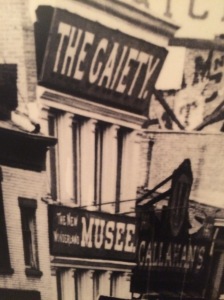Having a free evening and fine weather last night the Countess and I decided to take our copy of Eric Ferrara’s swell new book The Bowery: A History of Grit, Graft and Grandeur and head to that thoroughfare and see what we could see.
Of course, nowadays you can’t see anything. Actually that’s not true – there are several august old banks and even some 19th century residential buildings extant along the way. We were focusing on historic show biz venues, however, and of the many that once distinguished the street, the only one that may still partially exist from what I can tell is the structure of Miner’s Bowery Theatre, hidden by a hotel façade put up in the 1920s.
But I already knew that to be the case. There’s still a value in seeing where things were. I had done a similar jaunt several years to find the Lower East Side birthplaces of several vaudevillians. Again, everything is gone, but it is useful to use the imagination, and if nothing else, observe the spacial relationships between the various (former) points of interest. I was interested to note in this case that most of the stuff I was after was on the Southern end of the street, south of Houston, and is now strictly Chinatown, and the Electrical Lighting Fixtures District, known by real estate marketing peoples as ElElFaDa (I just made that up).
I’m not going to list the addresses of the various locations I’m about to mention. For that you’ll have to buy Mr. Ferrara’s book. Also the book mentions many more points of interest than I enumerate here; I’m just focusing on the theatre/ show biz angle. Here’s what we saw, or rather, didn’t see:
THEATRES
Bowery Amphitheatre, established 1835, and home to circuses and minstrel shows. It was also where P.T. Barnum worked as an ad writer just before he opened his own American Museum. Later the address hosted the New York Stadt Theatre and the Windsor Theatre
The Bowery Theatre, first known as the New York Theatre, Bowery, built 1826. It was New York’s third theatre and became known for its populist, nativist orientation, providing blood and guts melodramas to the masses. It is also the place where T.D. “Daddy Rice” debuted “Jumping Jim Crow”, launching the craze for blackface minstrelsy**. The location later became the Thalia Theatre, which specialized successively in German, Yiddish, Italian and Chinese theatre, reflecting the changes in the neighborhood.
The National Theatre, which premiered Uncle Tom’s Cabin in 1853. Later incarnations of the space included the International Garden Saloon, the National Garden, the Roumanian Opera House (a Yiddish theatre), the Liberty Theatre, the Nickelodeon Theatre (famed for a rowdy amateur night), the Manhattan Music Hall (a notorious den of vice that was shut down by the city) and finally the People’s Music Hall (a Yiddish house).
The Bowery Garden Theatre, which produced the city’s first Yiddish shows, was renamed the Oriental Theatre, and finally the New London Theatre.
Tony Pastor Opera’s House. Originally the Hoym Theatre, established 1858. Tony Pastor, accounted by some to be the Father of Vaudeville, took the place over in 1865. It later became Miner’s People’s Theatre and later just the People’s Theatre, a Yiddish venue.
The London Theatre, Henry Clay Miner’s first theatrical enterprise established 1876. Performers who trod the stage included Lottie Gilson, W.C. Fields, Weber & Fields and Eddie Cantor. Later it became the Lipzen Theatre (a Yiddish playhouse), the Variety Theatre, and the Caruso Theatre
Miner’s Bowery Theatre, home of a famously rowdy amateur night and the birthplace of “the hook”. Performers who get their start there included Weber & Fields, the Four Cohans and Eddie Cantor

George B. Bunnell’s New American Museum, the first of the dime museums, est. 1876. Bunnell had been an assistant of PT Barnum’s and one of his protégés was B.F. Keith who would go on to be one of vaudeville’s major entrepreneurs
Worth’s Museum and Congress of Living and Inanimate Curiosities, est 1881
Kahn’s Anatomical Museum, an elaborate freak show and grotesque science museum, est. 1893
Steve Brodie’s Saloon. Brodie became famous for claiming to have jumped off the Brooklyn Bridge in 1886. He devoted part of his saloon to a museum about the feat, toured in vaudeville, and was portrayed by George Raft in the 1933 movie The Bowery
Sammy’s New Bowery Follies, a nostalgic theme bar and tourist attraction with a stage show that evoked the old Bowery of yore. It operated 1934-1970.
OTHER POINTS OF INTEREST:
The Zoological Institute, built in 1833. An indoor menagerie compromising 4 city blocks, its collection included bears, tigers, monkeys, hyenas, snakes, vultures, zebras, rhinos, lions and elephants.
The Atlantic Beer Garden, an enormous entertainment emporium with a concert stage, bowling alleys, shooting gallery, saloon, and restaurant
The Germania Assembly Rooms, a.k.a the Volksgarten, home to many theatres
The Branch Hotel, where Stephen Foster died.
A storefront where P.T. Barnum sold “shoe blacking, cologne and bear grease” when he first moved to New York
A clubhouse where Tammany politician and vaudeville entrepreneur Big Tim Sullivan operated
And, while we’re at it, Sasquatch. We didn’t see that either!
Stay tuned for more on dime museums, concert saloons, minstrel shows, and variety theatres over the next few days!
**Obligatory Disclaimer: It is the official position of this blog that Caucasians-in-Blackface is NEVER okay. It was bad then, and it’s bad now. We occasionally show images depicting the practice, or refer to it in our writing, because it is necessary to tell the story of American show business, which like the history of humanity, is a mix of good and bad.

![2009_034[1]](https://travsd.files.wordpress.com/2011/05/2009_0341.jpg?w=300&h=196)
“There’s still a value in seeing where things were.” I couldn’t agree with you more! What a gift it is to have a great imagination. Thanks for your wonderful blog.
LikeLike
Thanks for reading it!
LikeLike